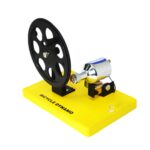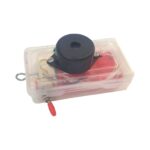- Pick up from the Samtech Store in Ambala
To pick up today
Free
- Courier delivery
Our courier will deliver to the specified address
4-5 Days
200+






₹2,000 Original price was: ₹2,000.₹750Current price is: ₹750. (Exc. GST)
To pick up today
Free
Our courier will deliver to the specified address
4-5 Days
200+
The core concept behind a seismograph is inertia—the tendency of a mass at rest to remain at rest.
In a model, when the base shakes (representing Earth during an earthquake), a suspended mass (pendulum or weight) remains relatively stationary while the frame moves.
This causes a relative motion between the frame and the mass, which is recorded as a trace on paper or displayed via a pen or laser pointer.
The seismograph records ground vibrations as a function of time.
It shows wave patterns: students can observe how different types of motions (slow, sudden, continuous) create different traces.
It mimics how real seismographs capture P-waves (primary), S-waves (secondary), and surface waves during real earthquakes.
Basic setup includes:
A base (representing the ground)
A frame with a hanging mass (representing inertia)
A pen or marker attached to the mass
A rolling strip of paper (or a sliding board) that moves beneath the pen
When the base is shaken:
The mass remains still due to inertia
The relative motion between the moving base and the mass causes the pen to draw a line on the paper
The intensity and frequency of shaking are represented by the pattern and amplitude of the line
Newton’s First Law of Motion (inertia)
Relative motion between moving systems
Wave motion and energy transfer
Vibration and resonance
How seismic waves travel through Earth
Differences between types of seismic waves
How scientists use seismograms to locate earthquake epicenters
The relationship between magnitude and wave amplitude
Design of sensitive instruments for real-world data collection
Understanding calibration, accuracy, and limitations
Real-time monitoring and alert systems
Simple DIY Model
Hanging mass + pen + paper roll
Built with cardboard, springs, or wooden frames
Best for visualizing basic seismic recording
Digital/Arduino Seismographs
Use accelerometers and sensors
Display data on screens
Can simulate real-time seismic activity
Good for advanced STEM integration
Earthquake detection and early warning systems
Tsunami prediction
Geological surveys and research
Helps students understand how data from seismographs are used to:
Determine earthquake magnitude
Find the epicenter
Study Earth’s internal layers
In stock
In stock
In stock
No account yet?
Create an Account
SAMTECH INSTRUMENTS
Typically replies within minutes
Any questions related to Seismograph Model?
🟢 Online | Privacy policy
WhatsApp us

